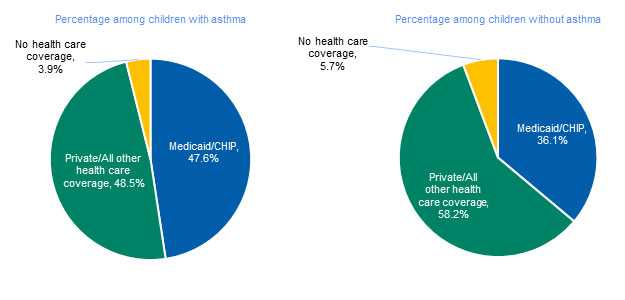Health Care Coverage among Children
More children with asthma than children without asthma had health care coverage through Medicaid or the Children’s Health Insurance Program (CHIP).

Having health care coverage that provides access to comprehensive health care services is important for detection and treatment of health conditions such as asthma.
Health Care Coverage: Most children both with asthma (96.1%) and without asthma (94.3%) had health care coverage at the time of interview. More children with asthma (47.6%) had coverage through Medicaid or the Children’s Health Insurance Program (CHIP) than did children without asthma (36.1%). More children without asthma (58.2%) had privately-funded health care coverage than did children with asthma (48.5%).
Age: Regardless of age, children with asthma (ages 0 through 4 years: 62.7%; 5 through 11 years: 48.2%; 12 through 17 years: 41.0%) were more likely to have health care coverage through Medicaid or CHIP. Children without asthma in the corresponding age groups (53.0%, 56.8%, 64.2%, respectively) were more likely to have privately-funded health care coverage.
Sex: Both boys (47.8%) and girls (47.5%) with asthma were more likely to have Medicaid or CHIP coverage than boys (35.9%) and girls (36.3%) without asthma. More boys (57.9%) and girls (58.4%) without asthma had privately-funded health care coverage than did boys and girls with asthma (47.9% and 49.4%, respectively).
Race/Ethnicity: Non-Hispanic white (33.5%) and non-Hispanic black (66.2%) children with asthma were more likely than those without asthma (22.6% and 55.9%, respectively) to have Medicaid or CHIP coverage. Among Hispanic and non-Hispanic other children with or without asthma there were no healthcare coverage differences.
Poverty: Regardless of asthma status, most poor children had health care coverage through Medicaid or CHIP (with asthma, 86.2%; without asthma, 81.6%). Among children who are near poor*, those with asthma (65.2%) were more likely to have Medicaid or CHIP coverage than those without asthma (55.4%). Children without asthma (85.9%) who are not poor were more likely to have privately-funded coverage than children with asthma (80.8%).
| Children with Asthma | Children without Asthma | |||||
| Medicaid/CHIP | Private/All other health care coverage | No health care coverage | Medicaid/CHIP | Private/All other health care coverage | No health care coverage | |
| % | % | % | % | % | % | |
| Total | 47.6 | 48.5 | 3.9 | 36.1 | 58.2 | 5.7 |
| Age(years) | ||||||
| 0-4 | 62.7 | 33.2 | 4.1 | 42.6 | 53 | 4.5 |
| 5-11 | 48.2 | 48.2 | 3.6 | 37.1 | 56.8 | 6.1 |
| 12-17 | 41 | 54.8 | 4.1 | 29.5 | 64.2 | 6.3 |
| Sex | ||||||
| Male | 47.8 | 47.9 | 4.3 | 36.9 | 57.9 | 6.1 |
| Female | 47.5 | 49.4 | 3.1 | 36.3 | 58.4 | 5.3 |
| Race/Ethnicity | ||||||
| NH White | 33.5 | 62.6 | 3.8 | 22.6 | 73.4 | 3.9 |
| NH Black | 66.2 | 31 | 2.8 | 55.9 | 38.8 | 5.4 |
| Hispanic | 61.8 | 32.6 | 5.6 | 56.6 | 33.3 | 10.2 |
| NH Other | 38.8 | 57 | 4.3 | 32.8 | 62.6 | 4.6 |
| Poverty Level * |
||||||
| Poor | 86.2 | 7.3 | 6.6 | 81.6 | 10 | 8.4 |
| Near poor | 65.2 | 30 | 4.8 | 55.4 | 34.7 | 9.9 |
| Not poor | 17.1 | 80.8 | 2.2 | 11.2 | 85.9 | 2.9 |
Abbreviations: NH, non- Hispanic; CI, confidence interval. *Poor” persons are below the poverty threshold. “Near poor” persons have incomes of 100% to less than 200% of the poverty threshold. “Not poor” have incomes that are 200% or above.
CDC’s National Asthma Control Program was created in 1999 to help the millions of people with asthma in the United States control their disease. The Program conducts national asthma surveillance and provides funds to states to help improve asthma surveillance and focus efforts and resources where they are needed.
Source: National Survey of Children’s Health, 2011-2012: children aged 0–17 years; questions: “Does the selected child have any kind of health care coverage, including health insurance, prepaid plans such as HMOs, or government plans such as Medicaid?” and “Is that coverage Medicaid or the Children’s Health Insurance Program, CHIP?”
- Page last reviewed: November 29, 2016
- Page last updated: November 29, 2016
- Content source:


 ShareCompartir
ShareCompartir